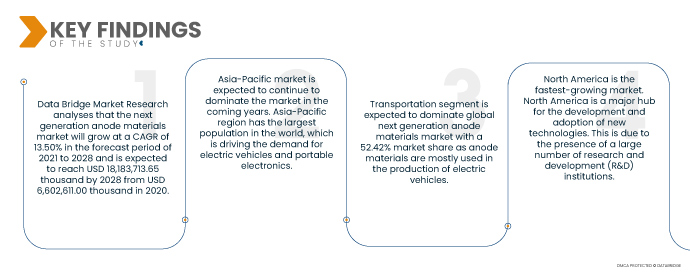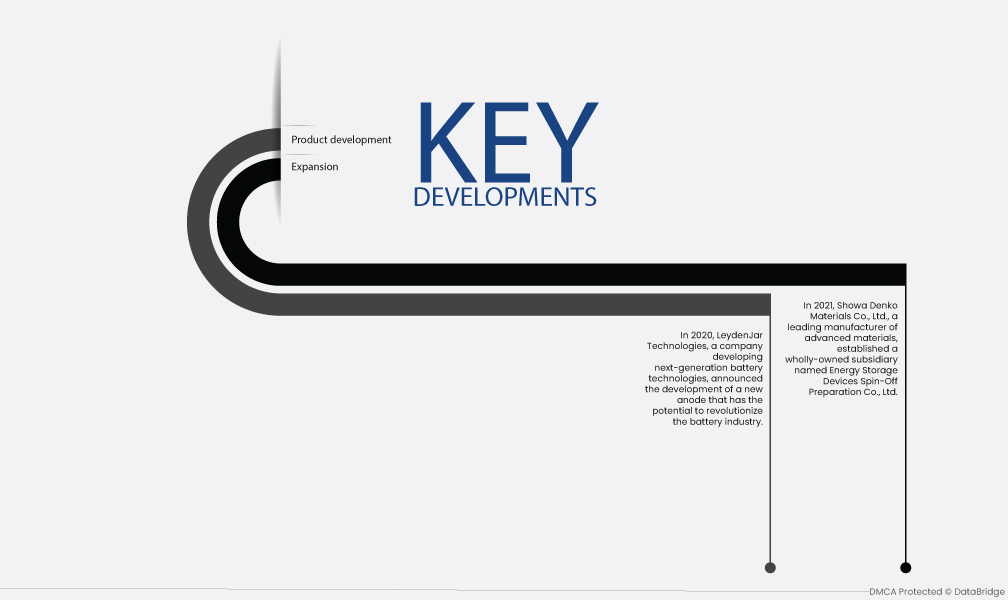Next generation anode materials (NGAMs) are a class of materials that have the potential to revolutionize the battery industry. NGAMs offer a number of advantages over traditional anode materials, such as higher energy density, longer battery life, and better safety. The development of NGAMs is still in its early stages, but the potential benefits are significant. As the technology continues to develop, NGAMs are likely to have a major impact on the battery industry and a wide range of other industries.
Access Full Report @ https://www.databridgemarketresearch.com/reports/global-next-generation-anode-materials-market
Data Bridge Market Research analyses that the Next Generation Anode Materials Market will grow at a CAGR of 13.50% in the forecast period of 2021 to 2028 and is expected to reach USD 18,183,713.65 thousand by 2028 from USD 6,602,611.00 thousand in 2020. Several drivers linked with the next generation anode materials market include the increasing demand for high energy density batteries and silicon's low cost, non-toxicity, and abundance, all of which favorably affect the industry's growth. The key driver of market growth is the increased demand for innovative anode materials to meet the demand for more competent batteries by various applications such as energy storage, electric vehicles, and electronic gadgets.
Growing demand for electric vehicles is expected to drive the market's growth rate
Electric vehicles are becoming increasingly popular, and this is driving the demand for next generation anode materials. Next generation anode materials offer a number of advantages over traditional anode materials, such as higher energy density and longer battery life. The development of new technologies, such as solid-state batteries, is also driving the demand for next generation anode materials. Solid-state batteries offer a number of advantages over traditional lithium-ion batteries, such as longer battery life and higher safety.
Report Scope and Market Segmentation
|
Report Metric
|
Details
|
|
Forecast Period
|
2021 to 2028
|
|
Base Year
|
2020
|
|
Historic Years
|
2019 (Customizable to 2013- 2018)
|
|
Quantitative Units
|
Revenue in USD Thousand, Volumes in Units, Pricing in USD
|
|
Segments Covered
|
Material (Silicon/Silicon Oxide Blends, Lithium Titanium Oxide, Silicon Carbon Fiber, Silicon Graphene, Lithium Metal, And Others), and Application (Transportation, Electrical and Electronics, Energy Storage and Others)
|
|
Countries Covered
|
U.S., Canada and Mexico in North America, Germany, France, U.K., Netherlands, Switzerland, Belgium, Russia, Italy, Spain, Turkey, Rest of Europe in Europe, China, Japan, India, South Korea, Singapore, Malaysia, Australia, Thailand, Indonesia, Philippines, Rest of Asia-Pacific (APAC) in the Asia-Pacific (APAC), Saudi Arabia, U.A.E, South Africa, Egypt, Israel, Rest of Middle East and Africa (MEA) as a part of Middle East and Africa (MEA), Brazil, Argentina and Rest of South America as part of South America
|
|
Market Players Covered
|
Amprius Technologies (U.S.), Albemarle Corporation (U.S.), Altairnano (U.S.), California Lithium Battery (U.S.), Showa Denko Materials Co., Ltd. (Japan), LeydenJar Technologies (Netherlands), NANOGRAF CORPORATION (U.S.), NEXEON LTD (U.K.), Shanshan Technology (China), OneD BATTERY SCIENCES (U.S.), pH Matter L.L.C. (U.S.), Sila Nanotechnologies Inc. (U.S.), Talga Group Ltd (Australia), JSR Corporation (Japan), Enovix Corporation (U.S.), and Paraclete Energy, Inc. (U.S.)
|
|
Data Points Covered in the Report
|
In addition to the insights on market scenarios such as market value, growth rate, segmentation, geographical coverage, and major players, the market reports curated by the Data Bridge Market Research also include in-depth expert analysis, geographically represented company-wise production and capacity, network layouts of distributors and partners, detailed and updated price trend analysis and deficit analysis of supply chain and demand
|
Segment Analysis:
Global next generation anode materials market is segmented into two notable segments which are based on the material and application.
- On the basis of material, the global next generation anode materials market is segmented into silicon/silicon oxide blends, lithium titanium oxide, silicon carbon fiber, silicon graphene, lithium metal, and others. Silicon/silicon oxide blends segment is expected to dominate the global next generation anode materials market with a 22.50% market share as silicon/silicon oxide blends are very lightweight and have high resistance power, which increases its demand globally
The silicon/silicon oxide blends segment will dominate the material segment of the next generation anode materials market
The silicon/silicon oxide blends segment will emerge as the dominating segment material segment. This is because of the growing number of silicon/silicon oxide blends manufacturers in the market especially in the developing economies. Further, growth and expansion of research development services on a global scale will further bolster the growth of this segment.
- On the basis of application, the global next generation anode materials market is segmented into transportation, electronics and electrical, energy storage, and others. Transportation segment is expected to dominate global next generation anode materials market with a 52.42% market share as anode materials are mostly used in the production of electric vehicles, which increases its demand globally.
The transportation segment will dominate the application segment of the next generation anode materials market
The transportation segment will emerge as the dominating segment under application. This is because of the growing number of infrastructural development activities in the market especially in the developing economies. Further, growth and expansion of the transportation industry all around the globe will further bolster the growth of this segment.
Major Players
Data Bridge Market Research recognizes the following companies as the major market players: Amprius Technologies (U.S.), Albemarle Corporation (U.S.), Altairnano (U.S.), California Lithium Battery (U.S.), Showa Denko Materials Co., Ltd. (Japan), LeydenJar Technologies (Netherlands), NANOGRAF CORPORATION (U.S.), NEXEON LTD (U.K.), Shanshan Technology (China), OneD BATTERY SCIENCES (U.S.), pH Matter L.L.C. (U.S.), Sila Nanotechnologies Inc. (U.S.), Talga Group Ltd (Australia), JSR Corporation (Japan), Enovix Corporation (U.S.), and Paraclete Energy, Inc. (U.S.).
Market Development
- In 2021, Showa Denko Materials Co., Ltd., a leading manufacturer of advanced materials, established a wholly-owned subsidiary named Energy Storage Devices Spin-Off Preparation Co., Ltd. This expansion was a strategic move to strengthen the company's position in the global energy storage market. The new subsidiary will focus on the development and commercialization of energy storage devices, such as lithium-ion batteries. Showa Denko Materials has a long history of developing and manufacturing advanced materials, and the new subsidiary will leverage this expertise to develop next-generation energy storage devices.
- In 2020, LeydenJar Technologies, a company developing next-generation battery technologies, announced the development of a new anode that has the potential to revolutionize the battery industry. The new anode is made from graphene, a two-dimensional material with high theoretical capacity. Graphene anodes have the potential to offer significant advantages over traditional anode materials, such as higher energy density and longer battery life. LeydenJar Technologies has already begun scaling up production of the new anode. The company plans to commercialize the new anode in the coming years. The commercialization of the new anode is expected to have a major impact on the battery industry. It could lead to the development of new battery technologies that are more efficient, affordable, and environmentally friendly.
Regional Analysis
Geographically, the countries covered in the market report are U.S., Canada and Mexico in North America, Germany, France, U.K., Netherlands, Switzerland, Belgium, Russia, Italy, Spain, Turkey, Rest of Europe in Europe, China, Japan, India, South Korea, Singapore, Malaysia, Australia, Thailand, Indonesia, Philippines, Rest of Asia-Pacific (APAC) in the Asia-Pacific (APAC), Saudi Arabia, U.A.E, South Africa, Egypt, Israel, Rest of Middle East and Africa (MEA) as a part of Middle East and Africa (MEA), Brazil, Argentina and Rest of South America as part of South America.
As per Data Bridge Market Research analysis:
Asia-Pacific is the dominant region in the next generation anode materials market during the forecast period 2021-2028
Asia-Pacific region will dominate the market in the coming years. Asia-Pacific region has the world's largest population, driving the demand for electric vehicles and portable electronics. The region is also a major market for portable electronics. This is due to the large population and the growing adoption of smartphones, laptops, and other portable devices.
North America is estimated to be the fastest-growing region in the next generation anode materials market in the forecast period 2021-2028
North America is the fastest-growing region. North America is a major hub for developing and adopting new technologies. This is due to the presence of a large number of research and development (R&D) institutions and the high level of investment in the technology sector. The demand for electric vehicles is also growing in North America. This is due to government incentives, rising incomes, and increasing environmental awareness.
For more detailed information about the next generation anode materials market report, click here – https://www.databridgemarketresearch.com/reports/global-next-generation-anode-materials-market












